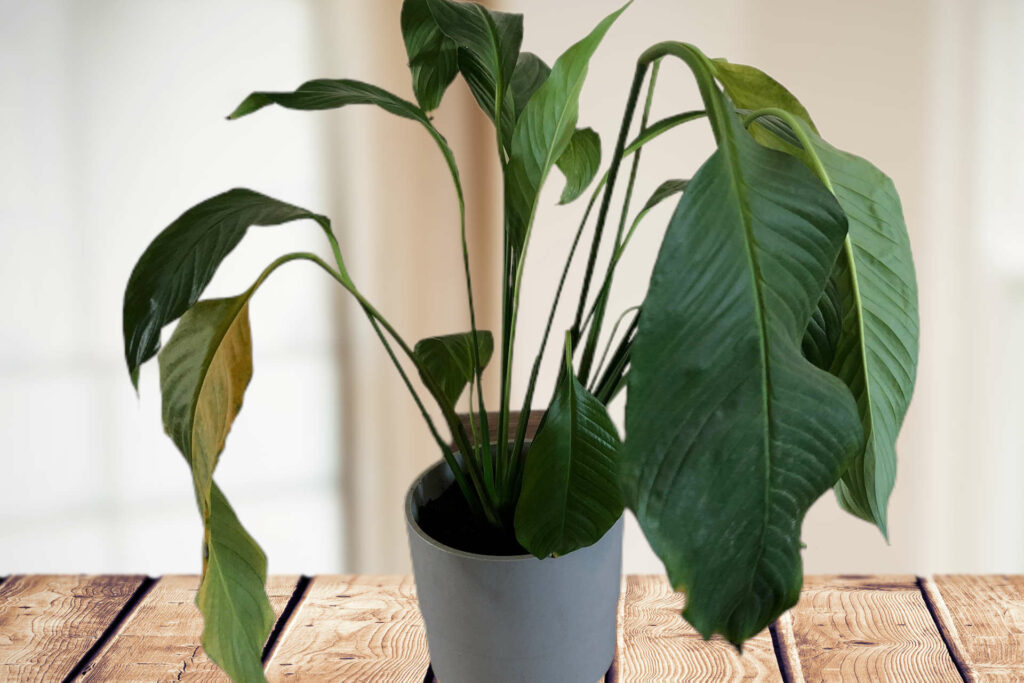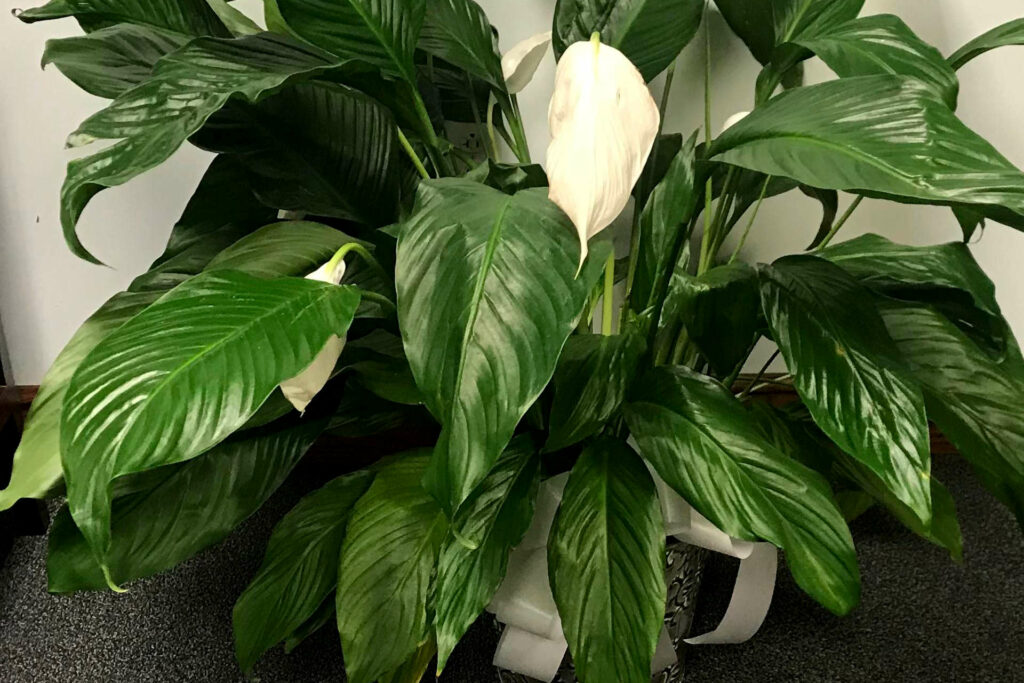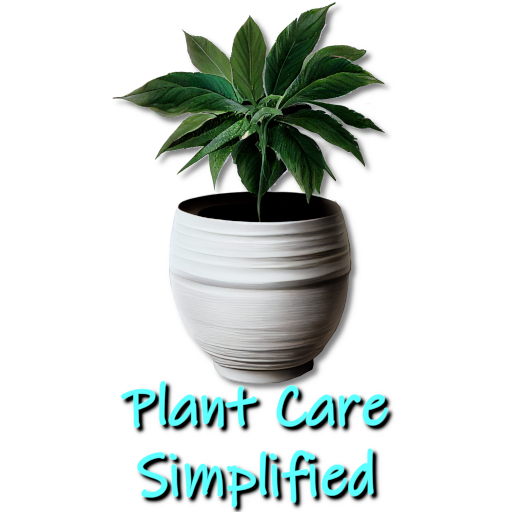Don’t Let Your Peace Lily Die! Here’s How to Fix Peace Lily Drooping Issues
Kim is passionate about helping people create beautiful, healthy indoor spaces that are filled with plants. Kim believes that plants make us happier, healthier human...
Is your peace lily drooping? If you feel you are taking care of your plant well, such a sign should be a cause for concern. If you are looking for both reasons and solutions, then below we provide details on the most common causes and how you should approach treating the issue.
Peace lilies, also known as Spathiphyllum, are popular and easy-to-care-for houseplants known for their ability to thrive in low-light conditions and purify the air. However, if you notice your peace lily starting to droop, several potential causes could be responsible. We will go through each in detail from poor environmental conditions to "overcare" issues.
Overview of Cause of and Treatments for Drooping Peace Lilies
If you've noticed your peace lily starting to droop/discolor, there could be one of several potential causes. Here's an overview of the seven most common reasons why your peace lily may be drooping:
| Cause | Description | Treatment |
|---|---|---|
| High indoor temperatures | High indoor temperatures can cause the leaves of your peace lily to lose turgidity, leading to drooping. It's important to keep your peace lily in moderate temperatures to prevent this from happening. | Keep your peace lily in moderate temperatures to prevent drooping. |
| Too much direct sunlight | While peace lilies prefer low-light conditions, too much direct sunlight can stress the leaves and cause them to droop. Make sure to keep your peace lily out of direct sunlight to prevent this from happening. | Keep your peace lily out of direct sunlight. Place it in an area with bright, indirect light or filtered sunlight. Rotate your peace lily regularly to ensure that all parts of the plant receive equal light. |
| Temperature fluctuations | Like most plants, peace lilies don't like constant changes in temperature. Drafts and temperature fluctuations can cause stress in your peace lily, leading to drooping. Keep your peace lily in a consistent environment to prevent this from happening. | Keep your peace lily in a consistent environment to prevent drooping. Avoid placing it in areas with strong drafts or temperature fluctuations. |
| Low humidity | Peace lilies thrive in high-humidity environments, so if the humidity in your home is low, it can cause the leaves to lose moisture and droop. Increase humidity by misting the leaves, using a humidifier, or placing the plant on a tray of pebbles and water. | Increase humidity by misting the leaves, using a humidifier, or placing the plant on a tray of pebbles and water. |
| Compromised root health | If you've recently repotted your peace lily or if the soil is too compacted, it can cause stress to the roots and lead to drooping. Make sure to properly re-pot your peace lily and use well-draining soil to prevent this from happening. | Use a well-draining soil mix to repot your peace lily in a pot that is only slightly larger than the current one. Ensure the pot has drainage holes to prevent excess water from accumulating and causing root rot. |
| Soil moisture levels | Both over- and under-watering can cause drooping in peace lilies. Check the soil moisture levels and water the plant appropriately to prevent this from happening. | Check the soil moisture levels regularly and water the plant appropriately. |
Getting to The Bottom of The Issue

Above, we have outlined the causes. reasons and potential treatments for recovering your peace lily. Now we will look at each of these on a more in-depth basis.
High Indoor Temperatures:
One potential cause of drooping peace lilies is high indoor temperatures. When the temperature inside your home becomes too high, it can cause the leaves of your peace lily to lose turgidity. Turgidity refers to the degree of swelling or firmness in plant cells, and the leaves need to remain erect. When the water pressure in the leaves drops, the leaves become flaccid and droop.
This means that the water evaporates from the leaves faster than the soil can supply, causing the leaves to become dehydrated and droop. This is especially common in peace lilies, native to tropical environments with high humidity. If you keep your peace lily in a dry, hot environment, it is more likely to suffer from drooping.
To prevent this from happening, keeping your peace lily in moderate to warm temperatures is essential. While peace lilies can tolerate a wide range of indoor temperatures, they do best in temperatures between 60-80°F (15-27°C). Avoid placing your peace lily in a location where the temperature regularly exceeds 85°F (30°C), as this can cause stress and lead to drooping. By keeping your peace lily at a comfortable, moderate temperature, you can help ensure that it stays healthy and vibrant.
Too Much Sunlight:
While peace lilies prefer low-light conditions, too much direct sunlight can stress the leaves and cause them to droop. Direct sunlight can cause the leaves of your peace lily to become scorched, leading to drooping and discoloration.
Peace lilies are native to tropical rainforests, growing under the canopy of taller trees. They receive indirect light and are protected from the sun's intense rays in their natural habitat. As a result, peace lilies are not adapted to handle long periods of direct sunlight.
To prevent drooping due to too much sunlight, keeping your peace lily out of direct sunlight is essential. Instead, place it in an area with bright, indirect, or filtered sunlight, providing the plant with the light it needs to thrive without causing stress to the leaves.
It's also a good idea to rotate/turn your peace lily regularly to ensure that all parts of the plant receive equal light. Doing so will help to keep the plant balanced and prevent the leaves from drooping or leaning toward the light source.
While peace lilies are known for their ability to thrive in low-light conditions, keeping them out of direct sunlight is essential to prevent drooping. By providing your peace lily with bright but indirect light, you can help to keep it healthy and prevent drooping/sagging.
Low Humidity:
Another common cause of drooping peace lilies is low humidity. As mentioned earlier, peace lilies thrive in high-humidity environments, so if the humidity in your home is low, it can cause the leaves to lose moisture and droop. There are several ways you can increase the humidity for your peace lily:
- Mist the leaves: Use a spray bottle to regularly mist the leaves of your peace lily, especially if the air in your home is dry. This will help increase the plant's humidity and keep the leaves hydrated.
- Use a humidifier: A humidifier can help to add moisture to the air, which can benefit your peace lily and other houseplants. Place the humidifier near your peace lily or use a cool mist humidifier to increase the humidity in the room.
- Create a humidifier for your plant by placing it on a tray of expanded clay aggregate (LECA) and water. The water will evaporate and increase the humidity around the plant. Ensure the bottom of the pot isn't touching the water to prevent over-watering.
Increasing the humidity around your peace lily can help prevent drooping and keep your plant healthy.
Compromised Root Health:

If you've recently re-potted your peace lily or the soil is too compacted, it can cause stress to the roots and lead to drooping. When re-potting, you should use a well-draining soil mix and properly re-pot your peace lily to ensure the roots have enough space to grow and receive the nutrients they need.
If you're re-potting your peace lily, use a pot slightly larger than the current one. Peace lilies prefer to be somewhat pot-bound, so a pot that is too large can cause the roots to become waterlogged, leading to drooping. Use a pot with drainage holes to prevent excess water from accumulating and causing root rot.
Soil/Potting Mix Moisture Levels:
Both over-watering and under-watering can cause drooping in peace lilies. It's essential to check the soil/potting mix moisture levels regularly and water the plant appropriately to prevent this from happening.
To check the soil moisture levels, stick your finger about an inch into the soil. If the soil/potting mix feels dry, it's time to water your peace lily. If the soil/potting mix feels moist, it's best to wait a few days before watering again.
Ensuring the soil/potting mix is well-draining to prevent water from accumulating will help avoid the possibility of root rot. If the soil is constantly wet or water is standing in the pot, it's best to re-pot your peace lily in a flowerpot with drainage holes or use a well-draining soil mix.
Nutritional Deficiency:
A lack of nutrients can also cause drooping in peace lilies. It's essential to fertilize your peace lily regularly with a balanced, water-soluble fertilizer to ensure it's getting the nutrients it needs.
A balanced houseplant fertilizer is perfect for peace lilies. Follow the instructions on the fertilizer label for the proper dosage and frequency of fertilization. It's best to fertilize your peace lily during the growing season, typically from spring to summer. During the winter months, you can reduce the frequency of fertilization to every 6-8 weeks or even stop fertilizing altogether.
Providing your peace lily with the proper nutrients can help prevent drooping and keep your plant healthy.
Nutritional Deficiency:
A lack of nutrients can also cause drooping in peace lilies. It's essential to fertilize your peace lily regularly with a balanced, water-soluble fertilizer to ensure it's getting the nutrients it needs.
Follow the instructions on the fertilizer label for the proper dosage and frequency of fertilization. It's best to fertilize your peace lily during the growing season, typically from spring to summer. During the winter months, you can reduce the frequency of fertilization or stop fertilizing altogether.
Providing your peace lily with the proper nutrients can help prevent drooping and keep your plant healthy.
Severe Drooping:

If you've tried the tips listed above and your peace lily is still severely drooping, it may be due to a pest infestation or a fungal or bacterial disease. Here are some tips for treating these issues:
Pest Infestation:
If you notice small insects, such as aphids or mealybugs, on your peace lily, it could signify a pest infestation. These insects can suck the sap from the plant and cause damage to the leaves, leading to drooping.
To treat a pest infestation, start by removing the insects by hand using a cotton swab or a soft cloth. Alternatively, you can use an insecticide specifically designed for indoor plants. Follow the instructions on the product label for the proper dosage and frequency of application.
Fungal or Bacterial Disease:
If your peace lily suffers from a fungal or bacterial disease, you may notice yellow or brown spots on the leaves or stem and drooping and wilting.
To treat a fungal or bacterial disease:
- Start by removing any infected leaves or stems.
- Dispose of these parts of the plant away from other plants to prevent the disease from spreading.
- Use a fungicide or bactericide specifically designed for indoor plants.
- Follow the instructions on the product label for the proper dosage and frequency of application.
It's also a good idea to practice good hygiene by sterilizing your pruning tools before and after use to prevent the spread of disease.
In summary, if your peace lily is severely drooping and doesn't improve with proper care, it may be due to a pest infestation or a fungal or bacterial disease. By removing pests or infected parts of the plant and using an insecticide or fungicide, you can help to treat these issues and prevent further drooping.
Kim is passionate about helping people create beautiful, healthy indoor spaces that are filled with plants. Kim believes that plants make us happier, healthier human beings, and she loves sharing her knowledge with others so they can experience the joys of plant care for themselves. <a href="https://plantcaresimplified.com/kim-marson/">Read more</a>
More Posts